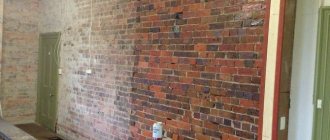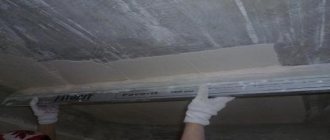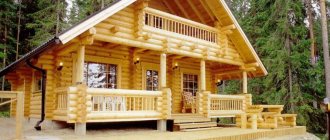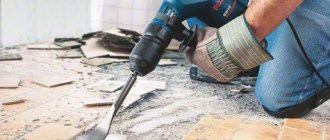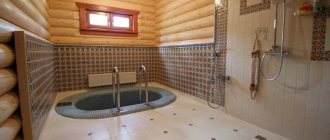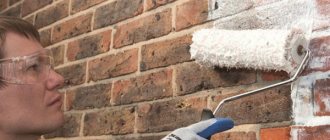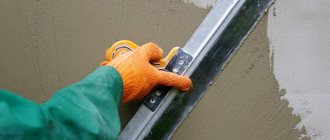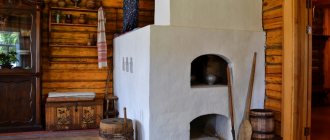How to cover up cracks to make it secure
To eliminate all kinds of holes that have formed during regular operation of the furnace, they try to use reliable compounds that cope with the problem the first time. In this section we will look at some of these tools.
Fireclay clay
Ready-made fireclay clay provides reliable sealing of joints that do not deform under constant exposure to high temperatures. The dried composition is characterized by a high level of vapor permeability and endurance when exposed to wet steam under high pressure.
Deep cracks on a brick wall from a home stove Source pechdoc.ru
The material is also considered environmentally friendly, since it does not emit toxic fumes when heated, and accordingly is harmless to people and animals. In order to prepare such a solution, you will need:
- one part of cement (grade “500”);
- two parts of fireclay clay (can be purchased at a special store);
- seven parts of river sand.
Factory-made masonry mixtures for laying stoves
We are talking about fireproof dry powders, which, after dissolving in water, turn into a homogeneous mass. The cooking recipe is usually indicated in the accompanying instructions. Along with the usual components (sand and cement), the solution contains special heat-resistant additives.
The refractory mixture for laying furnaces produced at the enterprise has a number of advantages:
- Well-calibrated composition. Under production conditions, careful dosage of each component is carried out, according to time-tested recipes and proportions.
- Specific additives. The components that give refractory mixtures their “proprietary” characteristics are often not commercially available (and sometimes even kept secret).
- Versatility. As a rule, industrial solutions are multifunctional: they can be used to lay stoves and then plaster finished walls.
- External aesthetics. Although a finishing finish is still applied over masonry or plaster, it is much more pleasant to work with an attractive-looking mortar.
Our stove makers especially liked the products of such manufacturers of masonry mixtures for stoves and fireplaces: “PLITONIT”, “TERRACOT”, “Makarov Stove House”, “Pechnik”, “Scanex”, “SPO”. As for the disadvantages of this type of material, it is usually called their high cost. In cases where it is necessary to save money, they try to use self-prepared heat-resistant solutions.
Working with mixture and fireclay bricks
Mixtures for laying fireproof stoves must be made with high quality
But it is equally important to do their proper installation.
Particular attention must be paid when filling the seams with mortar. If the filling is poor, water may get into the seams, and if it freezes, the masonry will crumble much earlier than planned.
The choice of brick laying category depends directly on the future temperature condition. The higher the temperature, the smaller the seam should be:
- 1 mm – first category;
- 2 mm – second category;
- 3 mm – third category;
- more than 3 mm – fourth category.
To determine the quality of the seam, I use a special probe with a width of 15 mm, and the thickness must be equal to the seam.
- The probe must penetrate 20 mm into the seam. To ensure that the bricks are positioned correctly, they are tapped with the handle of a trowel. To ensure that the seams are of a certain horizontalness, ordering slats are used and a cord is attached to them. After the first layer, the laying is determined only by this cord.
- The characteristics and reliability of masonry largely depend on the uniform application of the mortar to the surface.
Note: The brick sucks moisture out of the mixture, preventing it from drying out. Therefore, the brick is periodically wetted during the laying process, or even pre-soaked beforehand.
The fireproof mixture will help you make a quality structure, but you should never rush. You should look at photos and videos to understand the entire cooking process. After all, construction requires high-quality materials.
This is interesting: How to choose a set of drills: we explain the question
Video description
Plastering a brick oven with your own hands.
Special oven glue is not diluted in large quantities as it tends to harden quickly. After this, it cannot be used a second time, since repeated dilution will cause the composition to lose its strong qualities.
Using special oven glue to seal joints between brick joints in a home oven Source waysi.ru
What causes cracks
When malfunctions of the furnace equipment are discovered during use, the first thought that arises is: the furnace is cracking, what should I do? To begin with, it doesn’t hurt to figure out what led to this.
The following factors may be the reasons:
- donkey foundation or structure itself;
- unscrupulous craftsmen and unprofessional work;
- low quality material or unsuitable mortar for masonry or plastering was used;
- the drying process of the masonry is disrupted;
- long heating breaks, sudden temperature changes;
- the technology was not followed when applying each layer during plastering;
- The ventilation system is faulty, condensation.
Note!
Chipboard: what is it? Types, application features, photos, sizes, thickness, explanation, manufacturers
DIY houses made from shipping containers step by step: instructions, diagrams, pros and cons, photos, design
Working pressure in the heating system in a private house: what it should be, how to create it, instructions for adjusting it yourself
Guide to oven coating: technology to follow
If the question arises of how to coat the stove with clay or any other means to eliminate cracks, it is recommended to follow the algorithm below. It will make it possible to do all the work efficiently the first time and without additional modifications. The process consists of the following steps:
- In the resulting gap, remove any remaining old plaster and all dust. Next, deepen this crack by 1 cm. This way you increase the repair space, which makes the sealing process more convenient. Re-dispose of all waste.
- Coat all prepared areas with water and primer, and then heat the oven so that all the liquid evaporates. Put out the fire, when all the steam has completely disappeared, it should be emanating from the surface of the oven.
- While the walls of the structure are still hot, coat the prepared areas with a clay solution. At this point, it is important not to overdo it and apply a thin layer of oven caulk.
- Afterwards, take a reinforcing mesh or burlap and secure it with small self-tapping screws to the damage so that they completely overlap.
- Next, prepare the grout solution and carefully apply two layers to the defective areas using a spatula.
Leave the structure until completely dry. Remember that lighting a fire in it immediately after caulking in order to dry the seams faster is strictly prohibited. Trying to speed up the process will result in even more cracking. At this stage, the question of how to accurately coat the outside of the stove has been resolved.
Repairing a brick kiln against cracks in the seams Source sdelai-lestnicu.ru
Rules for preparing and applying ready-made mixtures
The advantage of purchased formulations is the ease of mixing the solution. To be able to prepare it, you will need a container of the appropriate volume and, without fail, a mixer or an electric drill with an attachment. The fact is that manually preparing a solution requires a certain amount of physical effort, and to make the work easier, more water is often added to it than it should be. As a result, there is a loss of quality of the finished mixture.
Preparation of the solution consists of pouring the dry mixture into warm water and stirring the mass until the lumps are completely dissolved. The consistency should be similar to thick sour cream. The solution is left for an hour, after which it is thoroughly mixed again.
Dry mixtures for laying fireplaces and stoves have water-retaining ability, so the bricks do not need to be pre-wetted. Firstly, it saves time, and secondly, it significantly reduces the period required to dry the masonry. The good elasticity of the solution, obtained through plasticizing additives, is reflected in the ability to make thin seams (2-4mm) and, as a result:
- on economical consumption of bulk material;
- on the attractive appearance of stove and fireplace walls;
- in the absence of cracks, which often appear in a thick masonry layer.
Heat-resistant compounds should be worked at an ambient temperature of no lower than +10 and no higher than +35 degrees. The solution can be applied in a layer of 10-12mm. Interestingly, seams made of fireclay clay mixture during the operation of the furnace acquire additional strength under the influence of heat.
Preparation of composition for laying fireclay bricks
A fireproof masonry mixture prepared on the basis of fireclay tolerates fairly high temperatures. Here you can use coal without any problems when heating, without worrying about the masonry. The preparation should be taken most carefully and responsibly, since if the components are calculated incorrectly or the manufacturing sequence is violated, the result may not be a completely suitable mixture for installation.
- We put the fireclay clay in a bucket and fill it with water so that it is not visible and leave it to infuse for about 12-72 hours. You will need to stir the soaked mixture from time to time.
- Then this clay will need to be rubbed through a sieve. It is best when the cell does not exceed 3x3 mm. Using the same sieve, you need to pass the sand and add it to the clay. Many experts consider the best ratio for masonry: 2 parts sand to 1 part clay. The dry composition of clay and sand must be mixed until smooth, and after that add water.
Attention: In order for the masonry composition to come out as good as possible, it must be constantly stirred when adding water. In this case, water should be added continuously, but in a small stream.
When the mixture becomes creamy, stop adding water. It is at this step that it is best to add salt to the solution.
- A regular bucket of mixture requires about 150 grams of salt. Salt gives the solution better strength. Then add about half a trowel of cement - it will strengthen the composition. In some cases, mixing with liquid glass occurs.
- A correctly prepared solution will flow down the shovel in an even layer, while an incorrect one will spread strongly or even become a lump. This mixture is the optimal choice for filling voids.
- The approximate amount of mortar for laying one hundred bricks is two buckets. In the case of laying out a Russian stove, the quantity must be increased by about twenty percent due to the specifics of the masonry.
A fireproof mixture is used for the fireplace and stove. By the way, the smaller the fraction of components, the higher quality the composition will be.
How to repair a firebox in a brick stove
If the question arises of how to repair cracks in a brick stove inside, you should try to minimize the heating of the walls using additional lining. This process involves the installation of special barrier partitions that absorb the entire thermal shock. The inside of the firebox is lined with one of the following materials:
- Cast iron. This is a fairly reliable type of raw material, it is distinguished by its durability and can withstand both loads and constant high temperatures. When introducing it, be sure to leave a small air gap between it and the brick wall.
- Steel. The material will last less than the previous one, since it tends to burn out quickly. An air cushion must be created behind such a layer. To maintain it at the same distance on all sides, a corrugated layer is laid. It will burn out after the first use of the stove, and the back space will remain free.
- Fireclay brick with markings ША-6 and ШБ-6. These models are not installed tightly to the stationary walls of the furnace. The approximate gap will be 7-10 mm. The brick is laid on fireclay mortar, which has increased stickiness.
Restoration of the firebox and removal of cracks in a brick kiln Source pechdoc.ru
Brick oven
The brick kiln is still in demand by people. Some populated areas are not gasified and a stove in a residential building is necessary. Sometimes it is an additional source of heat in order to save gas or electric heating.
In a country house you can not only spend the summer, but also celebrate New Year, Christmas and other holidays - romantic, unusual and healthy. A simple stove or fireplace will create comfort in the house; you will want to be at the dacha on weekends, sitting comfortably in the warmth.
When installing the stove, a number of conditions must be observed. In addition to choosing the correct design, installation location, components and materials, you need to understand what stoves are coated with so that they do not crack or crumble. A responsible attitude to the work at the construction stage of the building itself and the use of appropriate quality materials does not lead to cracks in bricks and finishing materials.
How to seal cracks in a metal stove
You may also need to decide how to cover the cracks in a metal stove, because it gradually burns out, and it is not always easy to allocate funds for repairs. Clay grout can be used as a restoration product. It is important to make a thick enough layer that will prevent combustion products from escaping from the firebox. The clay should be diluted in the traditional way, you can add a small amount of ash from the same oven and mix thoroughly until smooth.
Repairing a metal furnace by welding exfoliated metal fragments Source ipk-rotor.ru
If a hole or crack in the metal appears in the area where the chimney meets the stove chamber itself, then you need to take a small plate of metal, coat it with stove glue and fasten it to the deformed area. Seal the space on top with the same composition. To solve this issue, a reinforcing mesh is also used, which is subsequently plastered.
Heat-resistant mixture for masonry stoves
To give greater strength, concrete is also added to the material. In terms of its performance properties, such a solution will not be inferior to lime. Hardening of the concrete mass begins after 45 minutes. Before mixing the components, they are passed through a sieve. Then sand is poured into the prepared container, and cement is poured on top of it. This mass is mixed until a homogeneous composition is obtained. Then water is added. When mixing, it is necessary to achieve a viscous consistency. The solution should not be too thin or thick. To construct a monolithic firebox, components are used in the following ratio:
- 1 part Portland cement (M400);
- sand – 2 parts;
- brick crushed stone - 2 parts;
- fireclay sand - 0.3 parts.
Types of cracks and features of their repair
Having figured out how to coat a brick stove when deformations appear, you need to familiarize yourself with the types of cracks that appear. Conventionally, they are divided into cobwebs and other types. The first type of cracks is classified as non-through, and therefore their treatment is much easier. To seal a sealed surface in this way, you need to follow a step-by-step algorithm:
- clean the surface and use a chisel to remove excess plaster and debris that is stuck in the cracks;
- then clean the surface nearby with a metal brush, sweep away excess dust;
- treat the prepared surface with a primer so that it penetrates into the cracks;
- mix cement with water until the consistency of liquid sour cream is formed, take a brush and treat the damaged areas with it.
Go over the cracks several times to ensure the damage is completely filled. Otherwise they will appear again very soon.
Oven adhesive
In building materials retail outlets there is a dry adhesive special mixture, as well as a ready-made solution of fireclay clay and cement. This glue is durable and fire-resistant. It is convenient to fill the voids of bricks with ready-made plastic material.
The dry composition is not difficult to dilute in accordance with the instructions. It is recommended to work with a small amount of material, as it dries quite quickly. Along with the advantages, ready-made glue has the disadvantage of being quite expensive.
Video description
Oven for frying. How to put terracotta on glue.
On a note! In order not to make a mistake with the choice of grout, it is better to use ordinary clay, but first it should be checked for fat content. They do it this way: take five parts of clay and mix each of them with sand in different proportions, diluting with water. Then they make a bun from each mixture and throw it on the ground. The one that crashed is the fattest. Accordingly, the composition is ideal for sealing furnaces.
Is it possible to use a stove with cracks?
There is only one answer to this question: it is prohibited. Do not use a stove with cracks and endanger people’s lives. If there are no structural defects, it is necessary to begin troubleshooting as soon as possible.
Important! Fires in most cases result in death due to carbon monoxide released, not fire.
Clay-sand mixture
Affordable economy class material. To prepare the proper quality solution, only high-quality clay and river sand are used. The clay is poured with water in a convenient container and diluted to the state of milk, then rubbed through a fine sieve.
When the clay and water settle, the liquid top layer is drained. Sand, sifted twice, is added to the clay mixture, ratio 1:2. The liquid composition is diluted from the clay mixture to a creamy consistency and mixed thoroughly.
Note!
Three-way valve in a heating system: instructions on how to choose and install correctly in a private home
Why the bottom of the battery is cold and the top is hot - let's look at the reasons. Review of recommendations on what to do and how to fix it
How to insulate a dog house for the winter with your own hands and inexpensively - step-by-step instructions with photos and descriptions of all stages
It’s easy to check whether the solution is ready. If small pieces of the mixture remain stuck to the stirrer, then the solution is ready, and if large enough pieces remain, then by diluting with water the mixture is brought to the required condition.
A solution containing clay is more likely to lead to defects. There are no exact instructions for preparing the solution; it is prepared based on the experience of the master. There are not many professional craftsmen, so such a solution is not often in demand.
Making your own heat-resistant tile adhesive
To decorate with decorative tiles no thicker than ordinary tiles, use clay, cement and river sand in a ratio of 1:1:3
It is important to choose the right components
Particular attention is paid to clay, with which some difficulties may arise. It is checked as follows:
- Twist between palms into a tourniquet.
- Wrap the resulting tourniquet around a cylindrical object.
- The condition of the clay is assessed by the cracks formed. If only the top layer of the rope breaks, then the clay is oily and you need to add sand to it. The composition is considered normal if the breaks are evenly distributed along the entire length of the tourniquet and amount to 1/3-1/4 of its thickness. Deeper breaks (from ½ thickness) indicate that the clay is thin and needs a thickener.
The fattener is prepared independently:
- cut off the polyethylene canister;
- cover 1/5 of it with finely ground clay;
- pour water, mix;
- waiting for sediment to form;
- pour off half of the supernatant;
- the sediment is allowed to settle and used as a thickener.
Clay, cement and river sand are mixed dry, filled with water and kneaded by hand. The resulting solution should be of uniform consistency and normal viscosity (the mark from raking the correctly prepared composition does not tear or float). Add 200 g sodium chloride. The glue is ready for use.
What causes cracks to form on the stove?
A careful visual examination allows you to detect a large number of small cracks on the stove walls, which appear due to different rates of thermal expansion of brick and masonry mortar. These cracks can be easily repaired using a stove coating mixture.
If heating occurs unevenly in different parts of the furnace, the result is rupture of the masonry joints. This problem can also be solved simply by covering the crack with a new solution.
Cracks can form as a result of improper operation, when only the folded stove begins to be fired. However, even in this case, the problem of how to cover the stove is solved with the help of masonry mortar and plaster.
If there is no heating in winter, not only the stove, but also the walls of the house crack. This happens due to temperature changes. With the arrival of the warm season, it is necessary to heat the stove, dry the walls and masonry, prepare a new mortar and cover the cracks that have formed with it (about
Oven grout
To eliminate defects that occur in the oven, ready-made heat-resistant grout is sold. Because of its high cost, home craftsmen prefer to make such a solution themselves.
The clay is prepared as for a clay-sand mixture. The soaked clay slurry is combined with sifted sand and while mixing, chopped straw is added, the component ratio is 1:4:5. 1 kg of coarse salt is added to the finished solution, which makes the composition more plastic and resistant to cracking.
Grout perfectly fills voids. You can also use it to plaster the stove surface with the first rough layer.
How to plaster: choose a fireproof mortar
The main requirements for mixtures used for finishing home stoves and fireplaces include heat resistance, the ability to withstand temperature changes, high elasticity and resistance to cracking. Conventional solutions used in construction are not suitable here. The following types of heat-resistant mixtures are used for plastering stoves and fireplaces:
- clay-lime:
- cement-clay:
- clay-gypsum;
- mixed using several binders.
Manufacturers introduce different types of plasticizers into these mixtures, as well as moisture-retaining additives, with the help of which the rate of hardening of the solution is regulated. It is more convenient to work with them, since they set more slowly.
As a rule, two types of refractory compounds are produced. The first is used for rough primary finishing. It can be applied in a thick layer up to 10 mm. The second type of mixture is used only for final leveling of the surface. This layer is thinner, up to 3 mm. Finely dispersed components are introduced into the composition of the finishing solution, which makes it possible to obtain a perfectly flat and smooth surface, which can later be painted or covered with decorative plaster.
Terracotta mixture is popular among ready-made heat-resistant plasters for stoves. It consists of kaolin fireclay dust and functional additives. Withstands temperatures up to +400°C.
Work is carried out from +5°С to +35°С. Add 250 ml of water per 1 kg of plaster, mix, and let the solution sit for 15 minutes. After repeated mixing, the solution is used for 60 minutes. Apply a layer of up to 10 mm at a time, the mixture consumption will be 10 kg/m2. If you need to apply a second layer, you need to wait for the previous one to dry completely. In this case, ventilation should be natural, accelerated drying is not allowed to prevent the plaster from cracking.
Why is it prohibited to operate a faulty stove?
The oven can fail for various reasons. Sometimes it’s easier not to cover up any defects that appear, but to rebuild the stove. However, such drastic measures are rarely required. As a rule, the main reasons for the emergency condition are shrinkage, poor-quality materials and errors made when laying out the fireplace.
Heating systems require regular maintenance. According to SNiP standards, heating devices in a dacha must be inspected twice a year. And in a private house at least once a quarter. Unfortunately, most homeowners neglect these requirements.
Only a complete oven can be used
The main danger for the residents of the house is not a collapsed fireplace, but the cracks that appear in it. The explanation is simple - no one will heat a stove that is obviously in emergency condition, but cracks cannot always be noticed in time. Carbon smoke leaking through them is a serious danger for the inhabitants of the house. According to statistics provided by the Ministry of Emergency Situations, in a fire, 70% of people die from smoke, and of those who survive, 42% end up in hospital with carbon monoxide poisoning.
Therefore, timely repairs are the key to the safety of your family. Most stove makers, when asked: “how to cover the stove so that it does not crack from the heat?”, will advise using clay. However, there is a nuance here. There are several types of mixtures and almost all of them use clay.
Oven overheating
Having installed a new stove, or repaired damage to the old one, you should not test its strength by heating it to its fullest.
The first fire must be carried out with a small amount of firewood, increasing the amount each time. And then there will be no need to get rid of the next problems again.
